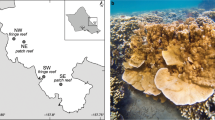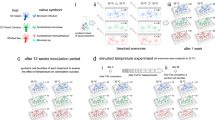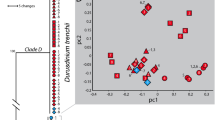Abstract
Many reef-building corals form symbioses with dinoflagellates from the diverse genus Symbiodinium. There is increasing evidence of functional significance to Symbiodinium diversity, which affects the coral holobiont’s response to changing environmental conditions. For example, corals hosting Symbiodinium from the clade D taxon exhibit greater resistance to heat-induced coral bleaching than conspecifics hosting the more common clade C. Yet, the relatively low prevalence of clade D suggests that this trait is not advantageous in non-stressful environments. Thus, clade D may only be able to out-compete other Symbiodinium types within the host habitat when conditions are chronically stressful. Previous studies have observed enhanced photosynthesis and fitness by clade C holobionts at non-stressful temperatures, relative to clade D. Yet, carbon-centered metrics cannot account for enhanced growth rates and patterns of symbiont succession to other genetic types when nitrogen often limits reef productivity. To investigate the metabolic costs of hosting thermally tolerant symbionts, we examined the assimilation and translocation of inorganic 15N and 13C in the coral Acropora tenuis experimentally infected with either clade C (sub-type C1) or D Symbiodinium at 28 and 30 °C. We show that at 28 °C, C1 holobionts acquired 22% more 15N than clade D. However, at 30 °C, C1 symbionts acquired equivalent nitrogen and 16% less carbon than D. We hypothesize that C1 competitively excludes clade D in hospite via enhanced nitrogen acquisition and thus dominates coral populations despite warming oceans.
Similar content being viewed by others
Main
Ocean warming is increasing coral reef mortality following mass bleaching events (Hoegh-Guldberg et al., 2007). Observations of thermal tolerance conferred by Symbiodinium clade D give hope that proliferation of D may enhance the corals’ resilience to bleaching by avoiding post-bleaching mortality (Stat and Gates, 2011). Higher post-bleaching survivorship has been observed in corals hosting clade D in the Coral Sea (Jones et al., 2008), eastern Pacific (Lajeunesse et al., 2010) and western Atlantic (Baker, 2001). However, clade D associations are generally found in low abundance in all but the warmest and/or most turbid coastal seas (Stat and Gates 2011), where as associations with clade C Symbiodinium are more prevalent (Baker et al., 2004). We hypothesized that, at non-stressful temperatures, the common clade C Symbiodinium (sub-type C1) is a better partner, acquiring, assimilating and transferring more photosynthetic resources in the form of carbon (C)-rich carbohydrates and nitrogen (N)-bearing amino acids to the host than clade D, but that the opposite is true under thermal stress. To test this hypothesis, we executed a 15NO3− and H13CO3− incubation experiment with juvenile colonies of Acropora tenuis experimentally infected with either clade C1 or clade D at both ambient (28 °C) and elevated (30 °C) temperatures (see Supplementary material for methods).
We contend that the use of 15NO3− and H13CO3− effectively isolates the coral’s autotrophic nutritional pathways as only the symbionts possess Rubisco and nitrate reductase enzymes for converting these inorganic substrates into organic products (Yellowlees et al., 2008). Indeed, we observed that 15N and 13C enrichments overall (expressed as atom percent or AP) were higher in the symbiont fraction than in the host fraction after 12 h of incubation. This indicates that the synthesis of isotopically enriched organic biomolecules within the symbiont preceded translocation to the host.
There was a significant difference in the amount of isotopically labeled nitrogen, but not carbon assimilated by clade C1 and D holobionts after 12 h at 28 °C (Figures 1 and 2). Although clade C1 and D Symbiodinium initially had similar AP13C and AP15N, after 12 h, clade C1 symbiont fractions had acquired 22% more 15N than clade D (Bayesian mean±s.d.; C1sym: 4.26±0.12 vs Dsym: 3.50±0.11; Figure 1b). Although we recognize that the sample sizes in this study are small (n=3 per clade per treatment), the magnitude of this signal was large. For context, in the stable isotope ‘δ’ notation, the difference in δ15N between clade D and C1 at 28 °C was 2191‰. A similar pattern was observed in the host fraction. Clade C1 hosts received 24% more 15N than D hosts after 12 h (C1host: 2.78±0.09 vs. Dhost: 2.24±0.09 Figure 2d), whereas there was no significant difference in carbon assimilation (Figure 2a).
Mean AP13C (a, c) and AP15N (b, d) in clade C1 and D Symbiodinium (symbiont fractions) sampled during a 12-h incubation with 15NO3− and H13CO3−. Left panels represent the ambient (28 °C) temperature treatment and right panels show results from the elevated (30 °C) treatment. Error bars represent 95% credible intervals (Bayesian). (*) Indicates significantly higher isotope assimilation between clades within each temperature treatment and (‡) represents a significant difference between temperature treatments within a clade as determined by no overlap of the 95% credible intervals.
Mean AP13C (a, c) and AP15N (b, d) of A. tenuis host fractions hosting either clade C1 or D Symbiodinium, sampled during a 12-hour incubation with H13CO3− and 15NO3−. Left panels represent the ambient (28 °C) temperature treatment and right panels show results of the elevated (30 °C) treatment. Error bars represent 95% credible intervals (Bayesian). (*) Indicates significantly higher isotope assimilation within each temperature treatment and sampling time as determined by no overlap of the 95% credible intervals between clades.
These observations suggest that Symbiodinium C1 has a competitive advantage for acquiring nitrogen at non-stressful temperatures, and this benefit is conferred to the host. This observation provides a compelling new mechanism for how C1 dominates coral populations via succession and competitive exclusion of D, despite clade D’s higher infection rates in juvenile hosts (Abrego et al., 2009). Given a limited pool of nitrogen within the host habitat, clade C1 Symbiodinium utilize this resource more efficiently, which could have the effect of increasing population growth while simultaneously inhibiting the growth of congeners which remain nitrogen-limited. This might explain why members of clade C remain globally dominant, as over time they can outcompete other clades for limiting nutrients. Moreover, differential nitrogen uptake and assimilation provides a more likely mechanism for enhanced growth rates observed in C1-dominated holobionts versus conspecifics hosting clade D (Little et al., 2004) as growth cannot be sustained by photosynthetic carbon fixation alone, especially when reef productivity tends to be nitrogen-limited (Muscatine et al., 1989; Fagoonee, 1999).
The relative patterns of nutrient acquisition by the two Symbiodinium clades were reversed at elevated temperature. At 30 °C, the mean AP15N attained by clade C1 was not statistically different from D (Figure 1d), illustrating that the enhanced nitrogen assimilation observed for C1 at 28 °C was eliminated with just a 2 °C increase in temperature. The 2 °C warming stimulated a 23% increase in 15N assimilation by clade D symbionts (D28 °C: 3.50±0.11; D30 °C: 4.32±0.10; Figure 1d). Furthermore, clade D fixed 35% more 13C than C1 (Dsym: 3.53±0.09 vs C1sym: 2.61±0.08; Figure 1c). This was attributed to a 23% decline in 13C fixation by C1 at 30 °C relative to 28 °C (C128 °C: 3.41±0.1 vs C130 °C: 2.61±0.08; Figures 1a,c), whereas mean AP13C of clade D remained unchanged across the temperature treatments. Although neither clade C1 or D host fractions showed a significant effect of temperature on AP13C (Figures 2a,c), there was a significant separation between the mean AP13C at 30 °C (C1host: 2.44±0.08 vs Dhost: 2.78±0.09; Figure 2c).
Clade D’s enhanced ability to acquire nitrogen at higher temperature may explain why this clade is commonly found in thermally stressful environments. Warming would enhance clade D’s nitrogen metabolism, thus allowing for increased rates of growth and proliferation within the host environment. Clade D’s competitive edge in chronically warm environments would be further strengthened by the impaired carbon fixation by clade C1 at elevated temperatures. The reduction of carbon fixation and translocation by C1 is indicative of reduced photosynthetic efficiency associated with elevated temperatures (Rowan, 2004; Hughes et al., 2010), whereas carbon fixation of clade D holobionts was increased with elevated temperature. The impairment of photosynthate translocation from symbiont to host has recently been identified as a key factor for coral bleaching. Hosts lacking energy derived from symbiont photosynthates may not sufficiently supply exogenous CO2 to their symbionts, thus increasing photorespiration, oxidative damage and symbiont expulsion (Wooldridge, 2009).
Taken together, these results shed new light on how biogeochemical cycles within the coral holobiont may underlie the relative distribution of symbiont types among their hosts. In particular, this study highlights the importance of differential thermal sensitivity of nitrogen metabolism within the coral holobiont. Coral symbioses evolved in oligotrophic seas. Therefore, we propose that competition for limited nitrogen affects symbiont abundance and diversity within the host. In our experiment, clade C1 symbionts obtained and translocated substantially more nitrogen than clade D, and slightly more carbon at non-stressful temperatures. This suggests an advantage for clade C1 holobionts for maximizing growth and fitness. However, at higher temperature, clade D maintained carbon fixation, whereas clade C1 declined. Clade C Symbiodinium may be more competitive, and may come to dominate adult colonies via succession at normal temperatures, whereas D persists in a small portion of the local population by enduring thermal stress.
Regardless of assertions that coral bleaching and/or symbiont shuffling may be an adaptive response to warming oceans (Jones, 2008), our results suggest that global increases in coral associations with thermally tolerant Symbiodinium will not occur as long as highly competitive congeners are able to re-establish themselves within the host during periods of low thermal stress. Much like terrestrial plant communities, we propose that the resource ratio hypothesis is applicable to competition among symbiont clades for growth limiting nutrients within the host environment (Tilman, 1985; Knowlton and Rohwer, 2002). In addition to nitrate, other nitrogenous compounds, phosphorus and trace metals are important targets for future studies of the effect on rising temperatures on the assimilation of limiting nutrients by diverse Symbiodinium lineages. Moreover, investigating the role of nitrogen pollution in disrupting coral–algal symbioses, perhaps by saturating in hospite nitrogen concentrations and thus favoring opportunistic and less efficient symbiont genotypes warrants further investigation (Wooldridge and Done, 2009). In addition to temperature and sedimentation, nitrogen saturation may be another important factor leading to higher proportions of clade D hosting corals in nearshore environments subject to terrestrial influence (Lajeunesse et al., 2010; Cooper et al., 2011). Finally, we emphasize the need to focus on essential elements in addition to carbon, such as nitrogen, which have important roles in shaping marine symbioses.
References
Abrego D, van Oppen M, Willis BL . (2009). Highly infectious symbiont dominates initial uptake in coral juveniles. Mol Ecol 18: 3518–3531.
Baker A . (2001). Reef corals bleach to survive change. Nature 411: 765–766.
Baker AC, Starger C, McClanahan T, Glynn P . (2004). Corals’ adaptive response to climate change. Nature 430: 741.
Cooper TF, Berkelmans R, Ulstrup K, Weeks S, Radford B, Jones AM . (2011). Environmental factors controlling the distribution of Symbiodinium harboured by the coral Acropora millepora on the Great Barrier Reef. PLoS ONE 6: e25536.
Fagoonee I . (1999). The dynamics of zooxanthellae populations: a long term study in the field. Science 283: 843–845.
Hoegh-Guldberg O, Mumby PJ, Hooten AJ, Steneck RS, Greenfield P, Gomez E et al (2007). Coral reefs under rapid climate change and ocean acidification. Science 318: 1737–1742.
Hughes A, Grottoli A, Pease T . (2010). Acquisition and assimilation of carbon in non-bleached and bleached corals. Mar Ecol Prog Ser 420: 91–101.
Jones A, Berkelmans R, van Oppen M, Meiog J, Sinclair W . (2008). A community change in the algal endosymbionts of a scleractinian coral following a natural bleaching event: field evidence of acclimation. Proc R Soc B 275: 1359–1365.
Jones R . (2008). Coral bleaching, bleaching-induced mortality, and the adaptive significance of the bleaching response. Mar Biol 154: 65–80.
Knowlton N, Rohwer F . (2002). Multispecies microbial mutualisms on coral reefs: the host as habitat. Am Nat 162: S51–S62.
Lajeunesse TC, Smith R, Walther M, Pinzón J, Pettay DT, McGinley M et al (2010). Host-symbiont recombination versus natural selection in the response of coral-dinoflagellate symbioses to environmental disturbance. Proc R Soc B 277: 2925–2934.
Little AF, van Oppen MJH, Willis BL . (2004). Flexibility in algal endosymbiosis shapes growth in reef corals. Science 304: 1492–1494.
Muscatine L, Falkowski PG, Dubinsky Z, Cook PA, McCloskey LR . (1989). The effect of external nutrient resources on the population dynamics of zooxanthellae in a reef coral. Proc Biol Sci 236: 311–324.
Rowan R . (2004). Coral bleaching: thermal adaptation in reef coral symbionts. Nature 430: 742.
Stat M, Gates RD . (2011). Clade D Symbiodinium in scleractinian corals: a “nugget” of hope, a selfish opportunist, an ominous sign, or all of the above? J Mar Biol doi:10.1155/2011/730715.
Tilman D . (1985). The resource-ratio hypothesis of plant succession. Am Nat 125: 827–852.
Wooldridge SA, Done TJ . (2009). Improved water quality can ameliorate effects of climate change on corals. Ecol Appl 19: 1492–1499.
Wooldridge SA . (2009). A new conceptual model for the warm-water breakdown of the coral-algae endosymbiosis. Mar Freshwater Res 60: 483–496.
Yellowlees D, Rees TAV, Leggat W . (2008). Metabolic interactions between algal symbionts and invertebrate hosts. Plant Cell Environ 31: 679–694.
Acknowledgements
We thank B Willis, CD Harvell and D Bourne for additional support and critical reviews of the manuscript. Special thanks to D Abrego for rearing corals, symbiont genotyping and assistance during the experiment. Comments from N Knowlton, CD Harvell, B Willis, K Kim, K Rogers and C Freeman greatly improved the manuscript. This work was funded by the World Bank/GEF Coral Targeted Research, Coral Disease Working Group, the Mario Einaudi Center for Environmental Studies at Cornell University, a small grant from the Cornell University NSF-IGERT program in Biogeochemistry and Environmental Biocomplexity, an EPA-STAR and Smithsonian Marine Science Network fellowship to DMB, and the WM Keck Foundation to MLF.
Author information
Authors and Affiliations
Corresponding author
Additional information
Supplementary Information accompanies the paper on The ISME Journal website
Supplementary information
Rights and permissions
About this article
Cite this article
Baker, D., Andras, J., Jordán-Garza, A. et al. Nitrate competition in a coral symbiosis varies with temperature among Symbiodinium clades. ISME J 7, 1248–1251 (2013). https://doi.org/10.1038/ismej.2013.12
Received:
Revised:
Accepted:
Published:
Issue Date:
DOI: https://doi.org/10.1038/ismej.2013.12
Keywords
This article is cited by
-
Lineage-specific symbionts mediate differential coral responses to thermal stress
Microbiome (2023)
-
Coupled carbon and nitrogen cycling regulates the cnidarian–algal symbiosis
Nature Communications (2023)
-
Symbiont-mediated tradeoffs between growth and heat tolerance are modulated by light and temperature in the coral Montipora capitata
Coral Reefs (2023)
-
Nutrient dynamics in coral symbiosis depend on both the relative and absolute abundance of Symbiodiniaceae species
Microbiome (2022)
-
Micronutrient content drives elementome variability amongst the Symbiodiniaceae
BMC Plant Biology (2022)





